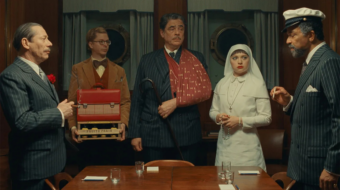
LOS ANGELES—The 19th annual South East European Film Festival, which deals with socialism more than any other major filmfest in Los Angeles and possibly America, opened May 1st—the international holiday of the working class, which was widely observed in Eastern Europe—and continues screening productions at L.A. venues through May 8. Founded by Sarajevo-born Vera Mijojlić, SEEFest includes many productions about socialism—albeit from critical viewpoints—as well as nonpolitical pictures. The eclectic Festival is the main U.S. portal for documentaries, features, shorts, animation, etc., from mostly former so-called “Iron Curtain” nations.
This includes Ukraine. For instance, in 2022 SEEFest screened Kiev-born Maryna Er Gorbach’s war-is-hell Klondike. This year, SEEFest presents Waking Up in Silence, a nonfiction short co-directed by Kiev’s Mila Zhluktenko about Ukrainian children confronted with their past as they explore their new home in Germany, a former Wehrmacht military barracks. Queer Fighters of Ukraine is a documentary short about the experiences of queer Ukrainians during wartime, directed by Angelika Ustymenko, a Ukraine-based non-binary queer artist and activist.
Here are my reviews of an excellent feature-length film SEEFest brought us this year:
Non-Aligned: Scenes from the Labudović Reels: The Big Six
Like Russian nesting dolls, Belgrade-born filmmaker Mila Turajlić’s Non-Aligned: Scenes from the Labudović Reels contains a film-within-a-film-within-a-film-within-a-film, and is one of the most brilliant political documentaries this film historian/critic has ever seen. The award-winning Turajlić expands the boundaries of conventional nonfiction films, just as other documentarians such as Dziga Vertov, Errol Morris, and Michael Moore have.
As its title implies, this motion picture’s subject matter relates to the Non-Aligned Movement, which was founded by Yugoslavia’s Josip Broz Tito, Indonesia’s Sukarno, India’s Jawaharlal Nehru, Egypt’s Gamal Abdul Nasser and Ghana’s Kwame Nkrumah. During the Cold War, these leaders forged a movement that eventually included 120-odd nations that didn’t formally belong to the USA or USSR Big Power blocs and sought an independent path dedicated to anti-colonialism and national sovereignty. As the narrator (who I believe is Turajlić herself) declares, because of NAM: “The Third World was not a place, it was a project.” A major NAM summit took place in 1961 in Belgrade, which was then the Socialist Federal Republic of Yugoslavia (today it’s Serbia’s capital).
The subhead of Non-Aligned is Scenes from the Labudović Reels, a reference to Stevan Labudović, the cameraman of Yugoslav President Tito, who chaired the historic 1961 NAM international conference. The documentary’s Belgrade summit footage was shot by Labudović, who also created so much more of the material in this multi-layered 100-minute chronicle. Like a cinematic sleuth, Turajlić tracks down long forgotten, never before seen 35mm celluloid lensed by Labudović, that was stashed away in reel cans literally gathering dust cached in state archives.
In addition to the NAM scenes, the globetrotting Labudović shadowed Tito on his many journeys abroad, often aboard the Galeb, the presidential yacht, as the Yugoslavian leader who defied both East and West sojourned far and wide in quest of new friends outside the Soviet- and U.S.-affiliated camps. In what may be the documentary’s most remarkable revelation, years before Gillo Pontecorvo’s 1966 The Battle of Algiers and Frantz Fanon’s The Wretched of the Earth, Labudović supported Algeria’s National Liberation Front, shooting newsreels proselytizing for the NLF’s revolution against France. Yugoslavia heeded Lenin’s dictum that: “For us, the cinema is the most important of the arts,” and developed a significant film industry, which it exported to Third World countries struggling for their national sovereignty. Who knew?
Another layer of this endlessly complex film is that the agitprop newsreels Labudović shot with his trusty Arriflex that were released did not have synchronized sound. So, for example, instead of hearing Sukarno’s speech at Belgrade, a narrator would summarize what he said, giving it a state spin. So, our gal Turajlić, that intrepid Sherlock, ferrets out sound recordings which she unearths at Radio Belgrade’s dusty archives, and then skillfully matches the sight and sound, wedding Labudović’s imagery with the actual speeches spoken by Sukarno, etc. Remarkable!
The discerning reader will notice that my subhead for this review of Non-Aligned is “The Big Six”—not the Big Five, which would solely be a reference to Tito and the four leaders who spearheaded NAM at the Belgrade summit and beyond. The sixth member of this group is none other than Stevan Labudović himself, the tireless cameraman who put that independent-minded quintet on the cinematic map.
Perhaps, upon reflection, I should have entitled this review “The Big Seven,” to embrace Ms. Turajlić, who has rescued the other six from obscurity. The Belgrade-born auteur’s documentary is filled with a yearning for a country and (she believes) an ideal that no longer exists. In black and white footage, we watch Labudović’s voyages aboard the Galeb during the 1960s, but onscreen we also see, in color, that yacht today, a rusty relic being towed. Is this Turajlić’s powerful movie metaphor for the Socialist Federal Republic of Yugoslavia?
The narrator wistfully says: “For six days in 1961 [before Turajlić was born] my city of Belgrade was the center of the Third World.” She goes on to describe NAM and her nation’s leadership role in it as “the essence of being Yugoslavian…. These archives are a tangible way to anchor this vision,” which the narrator fears is no longer remembered or relevant.
I highly recommend Non-Aligned: Scenes from the Labudović Reels, which is in B/W and color with English subtitles. But I have some questions regarding Turajlić’s astonishing documentary. As a predominantly white, European country, was Yugoslavia really part of the Third World per se, as the film maintains? The doc also suggests the Non-Aligned Movement, like Yugoslavia, no longer exists, but NAM persists in some form as the world’s largest grouping of nations after the U.N. (See here.) In any case, Mila Turajlić is an extraordinary talent, arguably former Yugoslavia’s most innovative director since Dusan Makavejev. Her work includes 2010’s doc Cinema Kommunisto, about “a country [Yugoslavia] that no longer exists—except in movies” (see the trailer here.)
SEEFest’s closing night gala featured Sarajevo Film Festival’s grand prize winner, Blackbird Blackbird Blackberry, by Georgian director Elene Naveriani.









